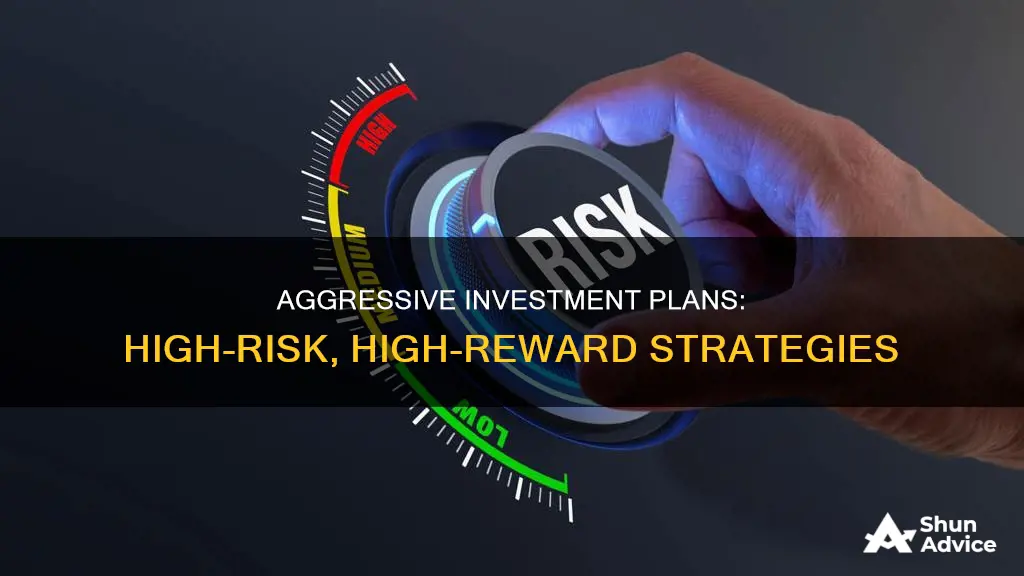
An aggressive investment strategy is a high-risk, high-reward approach to investing. It is suitable for younger investors with a higher risk tolerance and a longer time horizon. Aggressive investment strategies focus on capital appreciation instead of capital preservation or generating regular cash flows. This means that investors are willing to accept significant price fluctuations in exchange for higher potential returns. An aggressive investment portfolio is generally more heavily weighted towards stocks, with a smaller allocation to bonds and cash. While this approach carries a higher risk of losing money, it can also lead to significant gains.
| Characteristics | Values |
|---|---|
| Risk | High |
| Returns | High |
| Capital appreciation | Prioritized |
| Asset allocation | High-risk, high-reward assets such as equities, commodities, stocks, and possibly little or no bonds or cash |
| Investor suitability | Young investors with smaller portfolio sizes and a high tolerance for risk |
| Management | Requires active management and frequent adjustments |
What You'll Learn

High-risk, high-reward
An aggressive investment strategy is a high-risk, high-reward approach to investing. It typically involves a style of portfolio management that attempts to maximise returns by taking on a relatively higher degree of risk. This strategy prioritises capital appreciation as the primary investment objective, rather than income or safety of principal. As such, aggressive portfolios tend to allocate a substantial portion of their wealth to stocks, with little to no allocation to bonds or cash.
Aggressive investment strategies are generally suitable for young adults with smaller portfolio sizes and a higher tolerance for risk. This is because a lengthy investment horizon enables them to ride out market fluctuations, and losses early in one's career have less impact than in later years.
- Risk Tolerance: Aggressive investing carries a higher risk of losing money, so investors need to be comfortable with market fluctuations, losses, and other risks. A high tolerance for risk is crucial for this strategy.
- Time Horizon: Aggressive investing is typically a long-term approach. Investors should be willing to hold their investments for several years or even decades to allow for potential gains over time.
- Diversification: Spreading investments across various assets helps to reduce portfolio risk. By diversifying, investors can minimise losses in any specific asset or industry, protecting the overall value of the portfolio.
- Monitoring Investments: Aggressive investors must closely monitor their investments and be prepared to adjust their portfolio as market conditions and industry trends change. This may involve selling underperforming assets or investing in rising assets.
- Tax Implications: Different investments have varying tax advantages and disadvantages. It is important to understand these implications to make informed investment decisions.
Aggressive investment options that align with a high-risk, high-reward strategy include:
- Stocks: Stocks offer high returns, making them a popular choice for aggressive investors. However, they are also volatile and risky, with the potential for significant losses and gains.
- Mutual Funds: Mutual funds provide exposure to a wide range of assets and are professionally managed. However, they are subject to fees and may offer less direct control to investors.
- ETFs (Exchange-Traded Funds): ETFs are similar to mutual funds but are traded like stocks on an exchange. They offer diversification and exposure to a range of assets but are subject to market volatility and fees.
- Options and Futures: Financial derivatives such as options and futures can be used to speculate on market price changes or hedge risks. These investments are complex and carry a high level of risk but offer the potential for high returns.
- Real Estate: Real estate provides steady rental income and the potential for capital gains. However, it also comes with risks such as vacancies, property damage, and unexpected expenses.
- Alternative Investments: Private equity, hedge funds, and commodities are alternative investment options for aggressive investors. These often require higher minimum investment requirements than traditional investments.
India's Graphene Investment: Strategies for Success
You may want to see also

Suited to young investors
An aggressive investment strategy is a high-risk, high-reward approach to investing. It is suitable for younger investors with a higher risk tolerance and smaller portfolio sizes. Young investors have a lengthy investment horizon, allowing them to weather market fluctuations and recover from early losses.
An aggressive investment strategy focuses on capital appreciation rather than capital preservation or regular cash flows. It involves a portfolio with a substantial weighting in stocks and little to no allocation to bonds or cash. For example, an 80/20 portfolio allocates 80% of its wealth to equities and 20% to bonds, compared to a conservative 60/40 portfolio.
Young investors can benefit from the potential for higher returns over time, as small differences in returns can compound into significant gains. However, it is important to note that aggressive investing carries a higher-than-average risk of losing money.
Aggressive investment strategies may include investing in small-cap stocks, emerging markets, high-yield bonds, options, and private investments. These investments offer the potential for high returns but also carry significant risks.
Overall, while aggressive investment strategies can be suitable for young investors, it is crucial to have a high tolerance for risk and to carefully research and understand the potential risks and rewards.
Building an Investment Portfolio: Key Components
You may want to see also

Capital appreciation focus
An aggressive investment strategy is a high-risk, high-reward approach that focuses on maximising returns. This strategy is often recommended for younger investors with smaller portfolio sizes and a higher risk tolerance. The focus of an aggressive investment strategy is capital appreciation, targeting high-growth stocks and assets with the potential for rapid increases in value.
Capital appreciation refers to the rise in an investment's market price, or the difference between the purchase price and the selling price. It is one of the primary goals of aggressive investors, who seek to accumulate assets over the long term. This strategy is particularly appealing to those willing to take on additional risks for the potential of above-average market returns.
Capital appreciation funds, for example, invest in assets such as high-growth and value stocks, with the expectation of aggressive capital appreciation. These funds may also be called aggressive growth funds, reflecting their focus on capital appreciation. They are designed to deliver value to shareholders by investing in companies with appreciating share prices and are therefore heavily weighted towards equities.
A capital appreciation strategy often involves holding a diversified portfolio of 30-40 stocks that offer growth potential at a reasonable price. This approach ensures that the risk is balanced relative to the investor's goals and individual tolerance for volatility.
Aggressive investment strategies may also include a high turnover of stocks, chasing those that show high relative performance over a short period. This approach can lead to higher returns but also increases the risk of poor performance and higher transaction costs.
Overall, a capital appreciation focus is a key characteristic of an aggressive investment strategy, prioritising high-growth assets and rapid value increases while accepting a higher degree of risk.
Why You Should Diversify with International Equities
You may want to see also

High-yield bonds
The best way to invest in high-yield bonds is through a high-yield mutual fund, closed-end fund (CEF), or exchange-traded fund (ETF). This gives your portfolio better diversification across several issues of high-yield bonds and access to professional money management.
Tree Line Investment Management: What's the Deal?
You may want to see also

Real estate
An aggressive investment strategy is a high-risk, high-reward approach that focuses on maximising returns. It is generally more suitable for younger investors or those with a higher risk tolerance.
- Prioritise multifamily units: Investing in multifamily properties allows you to put down more cash, attract more tenants, and grow your portfolio quicker.
- Scout for properties in up-and-coming cities: Look for cities with the potential to rapidly increase in popularity in the next few years. This approach requires careful research and analysis, but it can pay off significantly.
- Be willing to leverage: Aggressive investors can consider borrowing more funds to invest in real estate. This strategy, known as financial leverage, can be powerful but also carries the risk of over-leveraging.
- Define clear criteria for purchases: Establish specific conditions for property purchases to enable faster decision-making and reduce hesitation.
- Minimise repairs and upgrades: Focus on essential maintenance rather than extensive renovations to reduce costs and speed up turnaround times.
- Reinvest your proceeds: Instead of cashing in profits, reinvest them into new properties to further grow your portfolio.
- Buy and sell strategically: Aggressive investing involves not only acquiring properties but also knowing when to sell and cut losses. If a property is not performing as expected, consider selling it to free up capital for more attractive investments.
- Consider emerging markets: Investing in real estate in emerging markets, particularly in Asia and Eastern Europe, can offer high growth potential. However, these markets also carry regulatory, political, and currency risks.
- High-yield bonds: Investing in high-yield bonds, also known as junk bonds, can provide higher returns but come with increased default risks.
- Private equity and venture capital: For investors with substantial capital, private equity and venture capital investments offer opportunities to directly fund start-ups or rapidly growing businesses. These investments are typically long-term and carry the risk of losing the entire investment if the business fails.
While an aggressive investment strategy can lead to faster growth and higher income, it is important to carefully consider the risks involved. Aggressive investing in real estate can lead to over-leveraging, vulnerability to market crises, and challenges in managing a rapidly growing portfolio. Additionally, it is crucial to maintain good relationships with agents, brokers, and sellers to ensure long-term success in the real estate industry.
FDI in India: Exploring the Attractive Investment Opportunities
You may want to see also
Frequently asked questions
An aggressive investment strategy is a high-risk, high-reward approach to investing. It focuses on capital appreciation instead of capital preservation or generating regular cash flows. An aggressive investment strategy is suitable for younger investors or those with a higher risk tolerance.
Examples of aggressive investment strategies include investing in stocks, mutual funds, ETFs, options, futures, real estate, and alternative investments such as private equity, hedge funds, and commodities.
An aggressive investment strategy may be suitable for investors with a long time horizon, a high-risk tolerance, and a priority on maximizing growth capital. It is important to carefully consider your risk tolerance, diversification, tax implications, and ability to monitor your investments before adopting an aggressive investment strategy.







